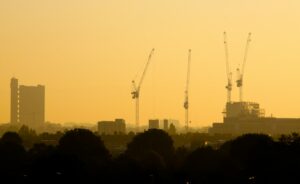A European Clean Air Working Group and a number of health organisations are demanding an end to what they describe as misleading information and mislabelling.
Wood burning should not be classed as a renewable energy source, according to the members of a new campaign which is calling on European Union member states to change how they classify the fuel.
The demands come in the form of an open letter penned and signed by the KLUG Clean Air Working Group and health organisations HEAL, EPHA, DGHP, and KlimaDocs. The document has been produced in response to the unveiling of new revisions to RED III, the bloc’s vision for increasing renewable energy capacity and use in a bid to slow the climate crisis and secure greater energy independence.
‘Promoting wood as a ‘renewable’ energy source is a misguided approach to climate change mitigation. Analyses have shown that burning wood produces more CO2 than burning coal, oil or gas. This is true for combustion in power plants, heating systems, and small wood burners in households,’ the letter reads. ‘In addition, forests are destroyed as natural CO2 sinks and may even become CO2
sources because of deforestation and other disturbances.
‘Furthermore, wood combustion is a major source of particulate matter emissions and fuels air pollution. In Europe, around 400,000 people die prematurely each year from air pollution,’ it continues. ‘Particulate matter (PM2.5) is absorbed into the bloodstream through the lungs, reaching all organs (even the brain), which can lead to many diseases, including cancer.’
The letter goes on to highlight that wood pellet stoves can cause more particulate matter than oil and gas, and Europe-wide health costs of wood-based home appliances are thought to be in the region of €12.6bn per year. The campaign has launched just weeks after a BBC Panorama investigation into Drax, operator of the UK’s largest power plant, which highlighted misleading environmental claims of wood burning, including sourcing wood pellets from primary forests in Canada to power the facility, which is located in Yorkshire.
Image: Zuzana Kacerová


















Drax share price slides as Ofgem launches probe into renewable reporting rules (msn.com)
Excellent, Martin. Thank you for explaining this. I was looking at an advert for wood stoves only this morning. It falsely describes wood and pellet burning as environmentlaly friendly. I supposed they mean that trees can be replanted? But there’s no guarantee is there? How would any one ever know? And what about the burning of branches picked up in the park? Far better to let them decompose naturally over time I would have thought. Burning of branches happens very fast and emits the CO2 all at once whcih is not good for the atmosphere. If we buy commercial logs instead, how can we be sure they really do come from sustainable forests? In terms of the heat given out per kg you need to burn more wood than coal so that is hardly an improvement is it? Quite apart from the emission of fine particulate air pollution, see this Working Group is European, so that means if they come up with any recommendations, regulations even, the UK won’t have to follow them. As well as PM2.5 from wood and pellet burning, there’s Ultra Fine Particles and Polyaromatic Hydrocarbons which are also very unhealthy for us to inhale. I totally agree, wood burning should not be called a renewable fuel – it can be, yes, but usually it isn’t. Nor should it be called eco-friendly, green or healthy. I am amazed at how the public has been taken in. Yes, many like to come home to a blazing fire or just a warm cosy glow after a long day at work. It’s traditional and somehow reassuring but time moves on. Scientists keep telling us it is not good for us, or for the forests we need to preserve and expand. Humans used to drink dirty water, and some still have to because that’s all there is, unfortunately, but we know clean water is so much better – it’s the same with dirty and clean air. Wood burning makes dirty air. Even these new stoves still emit pollution. Where the retailers say ‘UP TO 80 or 90% less emissions than an open fire’ that means nothing – the new stove could still be giving out only marginally less pollution than the fire or an old stove. There is no guarantee that the new stoves do any better at all, especially when people burn wet wood and rubbish in them. Perhaps anyone who has such a stove should get a meter and measure the PM2.5 they are making and see for themselves? Even then, what about the chimney emissions that go all over the street? Even when you can’t always see the smoke you can still smell it. That means you are breahing it in. Like cigarettes. The real problem seems to be fuel costs right now. I worry that we are in for a very smoky winter in UK, Europe too. The commericial products are expensive and some people will resort to burning damp and tainted wood from anywhere. Far better to let the trees continue growing and absorbing CO2 and not to burn unless we must.
There’s also the simple matter of time – we don’t have enough! 20 minutes to burn a log and release the carbon, 30 to 100 years for a tree to grow to recapture the released carbon and 7 years, probably less, to reverse the current direction of climate change. Every log burnt on every stove contributes to climate change.